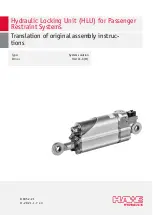
Comfort locking
When the restraint system is open, the double-sided locking of valve V2 (2) prevents the hydraulic
cylinder (7) from retracting under load. Riders can use the restraint system as a handhold when
entering and exiting the ride. Further closing of the restraint system too tightly is prevented while
the ride is running. Both functions enhance rider comfort.
Closing the restraint
system
When valve V2 (2) is energized, the restraint system can be closed. When the restraint system is closed,
the piston rod (9) of the hydraulic cylinder (7) retracts, lling the hydraulic accumulator (6). A hydraulic
pressure is built up and maintained in the process. The restraint system is closed.
The piston rod (9) is prevented from extending by the non-energized check valve V1 (5), and the
restraint system cannot be opened.
Primary function:
Locking the restraint
system
When the restraint system has reached its end position, valve V2 (2) is de-energized. The piston rod (9)
can neither retract nor extend. The restraint system is thus locked, and can be neither opened nor closed.
Secondary function:
Opening the restraint
system
The hydraulic locking unit acts as a bar drive. The piston rod (9) extends by extension force as soon as
V1 (4) is energized and thereby opened. The hydraulic pressure is relieved, and the restraint system bar is
actively opened.
3.2.4 Type DL (RE): Blocking against retraction with comfort lock
The hydraulic locking unit is connected via the rod ends (1) and (11) to the ride’s restraint system (such
as the shoulder bar mechanism).
Comfort locking
When the restraint system is open, the double-sided locking of valve V2 (2) prevents the hydraulic
cylinder (7) from retracting under load. Riders can use the restraint system as a handhold when
entering and exiting the ride. Further closing of the restraint system too tightly is prevented while
the ride is running. Both functions enhance rider comfort.
Closing the restraint
system
When valve V1 (5) is energized, the restraint system can be closed. When the restraint system is closed,
the piston rod (9) of the hydraulic cylinder (7) is extended. The hydraulic pressure in the accumulator (6)
is relieved, ensuring correct internal ow of hydraulic uid.
The piston rod (9) is prevented from retracting by the non-energized check valve V2 (2), and the
restraint system cannot be opened.
Primary function:
Locking the restraint
system
When the restraint system is closed, the piston rod (9) of the hydraulic cylinder (7) is extended and
locked to stop it retracting. The hydraulic pressure in the accumulator (6) is relieved, and holds the
piston rod in position hydraulically.
When the restraint system has reached its end position, valve V1 (5) is de-energized. The piston rod (9)
can neither retract nor extend. The restraint system is thus locked, and can be neither opened nor closed.
Secondary function:
Opening the restraint
system
Type DL (RE) locking units always generate very low piston extension forces by design. When valves
V1 (5) and V2 (2) are energized, and thereby opened, the piston rod (9) of the hydraulic cylinder (7)
remains extended, and can only be retracted by an additional system.
It is not possible to drive the restraint system's opening motion by way of the locking unit. The low
extension forces produce a force that closes the restraint system. An additional system (such as a gas
spring or leg spring) is therefore required to drive the opening motion and keep the restraint system
open.
HAWE Hydraulik SE
B 6052-21 -
11
-2021 - 1.7
15/63
















































